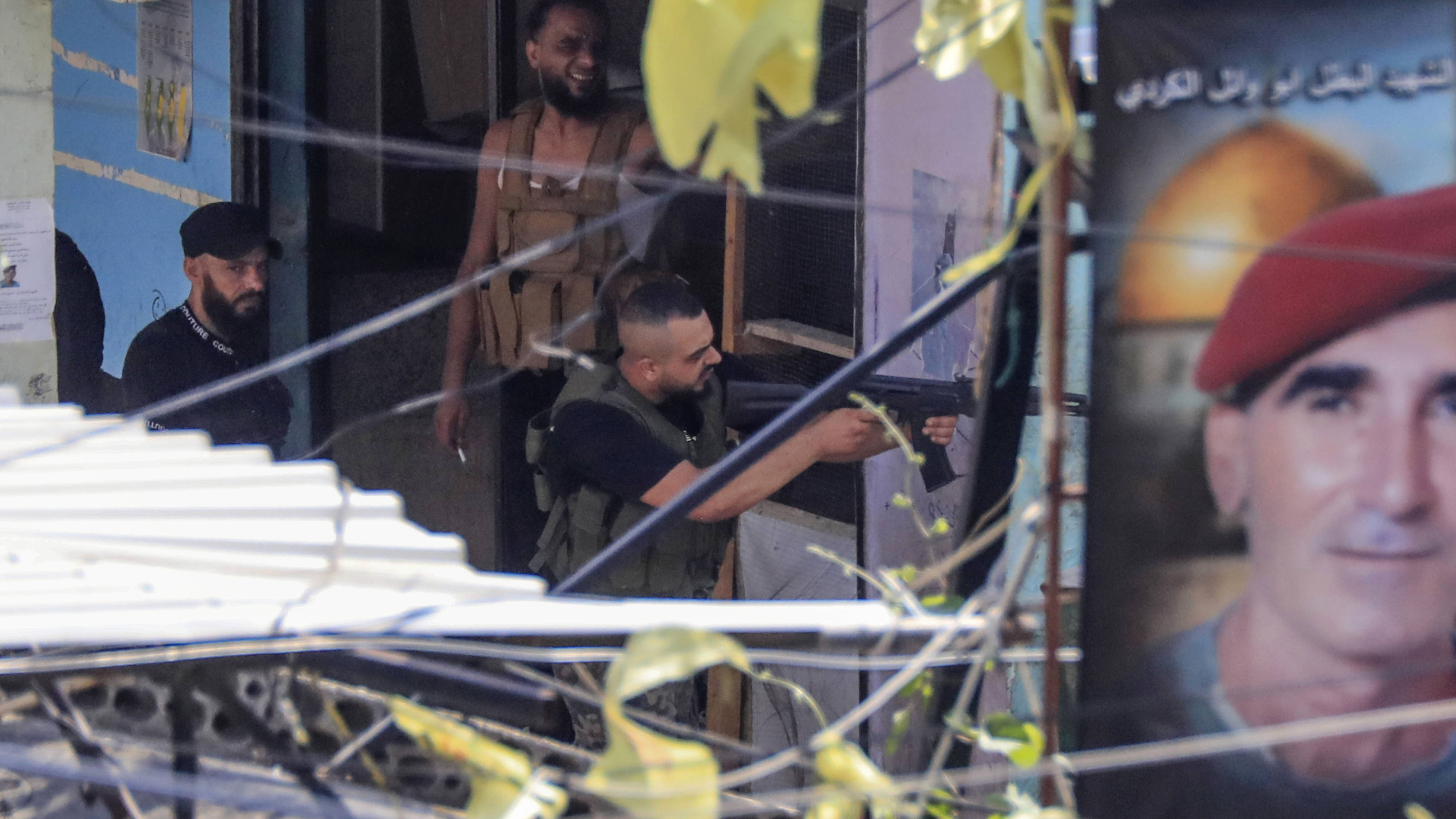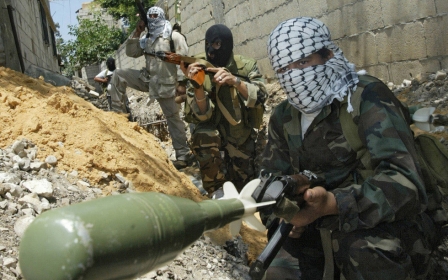Lebanon: Ain al-Hilweh's Palestinian fighters blame internal 'infiltration' and Israel for clashes

A cautious calm prevails in the Ain al-Hilweh Palestinian refugee camp in Lebanon days after clashes between fighters from the Fatah movement and those from the Shabab al-Muslim (Muslim Youth) coalition.
The latest flare-up started on 7 September after a fragile ceasefire between the rival factions broke down.
Tensions have been high since a failed assassination attempt in late July against a local militia leader, Mahmoud Khalil, and the subsequent ambush on Fatah fighters, which killed a senior Fatah commander, Abu Ashraf el-Armoushi, along with four of his guards.
The latter attack is suspected to have been a response to the initial assassination attempt.
Sporadic and deadly fighting has continued since then amid attempts by other armed groups, such as Hamas and Lebanon’s Amal movement, to quell the violence.
New MEE newsletter: Jerusalem Dispatch
Sign up to get the latest insights and analysis on Israel-Palestine, alongside Turkey Unpacked and other MEE newsletters
Within the camp's confines, life is gradually resuming its rhythm. In areas untouched by the recent strife, some residents have reopened their shops, even amid the military presence of various factions.
In the areas affected by the fighting, homes lay abandoned, many reduced to rubble, rendering them uninhabitable.
The September round of clashes engulfed multiple neighbourhoods in the camp, including Hittin, Baraksat, Tawari, Taamir, Safsaf, Ras al-Ahmar, Tiri, and Jabal Halib.
Despite the ongoing calm, the threat of violence remains ever present as Fatah has given its rivals until the end of the month to hand over Armoushi’s killers into their custody.
Palestinian refugee camps in Lebanon have traditionally been self-administered with Lebanese security forces and militias taking a hands-off approach towards them.
‘A plot’
Figures within both sides say they do not want the situation to escalate and are simply responding to attacks from the other side.
A leader in a local armed group, which rivals Fatah, told Middle East Eye on condition of anonymity that his group had no intention of controlling territory in the area but blamed the Fatah movement for acting provocatively.
“Last time this neighbourhood [Ras al-Ahmar] was not part of the clashes, but this time members from [Fatah] started firing bullets at us - we had to stop it,” he said, adding: “They were not only attacking us but also civilian houses; you can ask anyone in this neighbourhood, and they will tell you that we did not start anything.”

There is a lot of distrust between the two sides but ironically both suspect some outside interference is adding fuel to the fire, if not outright stoking the violence
“What we're witnessing is a plot to dismantle our camp with the Israeli occupation being the sole beneficiary,” the source said.
A high-level source from the Fatah movement, who also wished to remain anonymous, echoed this sentiment.
“I will be sincere with you, what is happening here in our camp is being mapped by the Israelis, and it is both from our side and the Islamists’ side.
“We are both infiltrated, I cannot pinpoint who and how but take my words that we are both infiltrated and all of this violence you have seen is a result of that.”
The claims of outside interference cannot be independently substantiated but have nevertheless also become a theme of local Lebanese media coverage of the fighting.
Besides claims of Israeli involvement, there are also accusations that some of the fighters on the Shabab side have fought with armed groups in Syria.
However, the Fatah source said the fighting largely involves men who are from the camp, as well as some Lebanese locals and Palestinians from Syria, who no longer live there because of the conflict.
Speaking of the opposing sides, he said: “I consider them all my sons in the camp, but I cannot deny that they are infiltrated and some of them are the reason for what is happening. Who killed Al-Armoushi in the first place?”
Another element prolonging the fighting, he explained, was internal discord within Fatah.
“Our younger members are fervent and often defy the central command,” he said. “The political leadership agrees on a ceasefire but on the ground nothing happens, and the fire continues.”
Caught in the middle
In the wake of the most recent clashes, the camp's refugees find themselves grappling with another episode that compounds their dire situation.
Areas of the camp such as Taware and Hittin bore the brunt of the devastation and now resemble war zones.
In Ras al-Ahmar, the situation is less devastating, but residents have nevertheless left because of the proximity of the clases.
Ali Salameh guided this reporter through his home, now a charred shell after catching fire in the skirmishes.
“This is the first time I've had to abandon my home. I typically stay put, but the violence reached our doorstep this time, and our losses are substantial,” he said, while navigating the remnants of his dwelling.
“Thank God my family is safe, but who will compensate for our loss? This home was all we had. Now we find ourselves scattered, each member taking refuge in different households.
“The uncertainty is overwhelming, and we are unsure if this round of violence has truly ended.”
The fighting has caused the mass displacement of Palestinian civilians from the camp, especially in the Hittin neighbourhood, which was struck by heavy artillery, according to UNRWA documents. The UN agency is responsible for the welfare of Palestinian refugees, including those in Lebanon.
Those fleeing the fighting have found refuge in nearby mosques, schools and even the Sidon municipality building.
UNRWA's data corroborates the mass departure from the camp, noting that its emergency shelters are nearing full capacity.
The organisation is at the forefront of the crisis, pouring $15.5m in aid to assist the displaced and to continue to provide education for children. According to the agency, armed factions have commandeered eight schools during the crisis.
Scars of conflict
The exact number of deaths remains a point of contention, as both factions stop issuing details of their losses.
Nonetheless, the director of the nearby Hamshari hospital acknowledged the deaths of about 17 people in the latest round of violence, with about 140 wounded.
Beyond the camp's boundaries in the neighbouring Lebanese city of Sidon, residents also carry the physical and emotional scars of the conflict.
Stray bullets have damaged infrastructure and helped foster a pervasive sense of fear among the populace.
Lebanon’s National News Agency reported damage to the Sidon municipality building and the Lebanese University has been closed as a precaution.
This article is available in French on Middle East Eye French edition.
Middle East Eye delivers independent and unrivalled coverage and analysis of the Middle East, North Africa and beyond. To learn more about republishing this content and the associated fees, please fill out this form. More about MEE can be found here.





